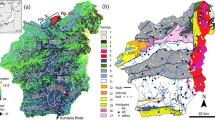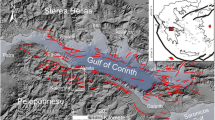Abstract
Because of the rapid uplift of the Tibetan Plateau since the middle and late Pleistocene, the surrounding mountainous areas of the Tibetan Plateau also show a rapid uplift trend. The study area is located in the upper reaches of the Jinsha River, southeastern Tibetan Plateau. Tectonically, the study area is located in the eastern segment of the Jinshajiang suture zone, which is the weak belt of the lithosphere. Affected by the rapid uplift, steep slopes are formed by the rapid vertical down-cutting of rivers in the studied reach. Under the sustained action of the gravitational field, the deformation and failure of slopes readily occur. To better formulate development and risk mitigation plans, a mass movement inventory map at the scale of 1:50,000 was prepared for the 100 km long reach. A total of 247 mass movements of different types, sizes and relative ages were mapped via image interpretation and detailed field survey. The statistical analysis of their spatial distributions was performed using two relative concentration indexes. The correlations between the spatial distribution and six common factors were analyzed: elevation, slope angle, slope aspect, lithology, active fault, and river system. The geomorphological survey shows that the mass movements locally play an important role in the present-day landscape evolution. In addition, the geomorphic features indicate that the mapped giant landslides can be classified as very old landslides, and they very likely occurred under a different morphoclimatic environment than that of the present.















Similar content being viewed by others
References
Ahmed MF, Rogers JD (2016) Regional level landslide inventory maps of the Shyok River watershed, Northern Pakistan. Bull Eng Geol Environ 75:563–574
Ahmed MF, Rogers JD, Bakar MZA (2016) Hunza river watershed landslide and related features inventory mapping. Environ Earth Sci 75:523
Angillieri MYE, Perucca LP (2013) Mass movement in Cordon de las Osamentas, de La Flecha river basin, San Juan, Argentina. Quat Int 301:150–157
Binnie SA, Phillips WM, Summerfield MA, Fifield LK (2007) Tectonic uplift, threshold hillslopes, and denudation rates in a developing mountain range. Geology 35:743–746
Cao WT, Yan DP, Qiu L, Zhang YX, Qiu JW (2015) Structural style and metamorphic conditions of the Jinshajiang metamorphic belt: Nature of the Paleo-Jinshajiang orogenic belt in the eastern Tibetan Plateau. J Asian Earth Sci 113:748–765
Chacon J, Irigaray C, Fernandez T, El Hamdouni R (2006) Engineering geology maps: landslides and geographical information systems. Bull Eng Geol Environ 65:341–411
Chen J, Dai FC, Yao X (2008) Holocene debris-flow deposits and their implications on the climate in the upper Jinsha River valley, China. Geomorphology 93:493–500
Chen J, Dai FC, Lu TY, Cui ZJ (2013) Holocene landslide-dammed lake deposits in the upper Jinsha River, SE Tibetan Plateau and their ages. Quat Int 298:107–113
Clark MK et al (2004) Surface uplift, tectonics, and erosion of eastern Tibet from large scale drainage patterns. Tectonics 23:TC1006
Cruden DM, Varnes DJ (1996) Landslides: investigation and mitigation. In: Turner AK, Schuster RL (eds) Landslides, investigation and mitigation. Transportation research board, US National Research Council. Special Report 247, Washington, DC, pp 36–75
Deng J, Wang QF, Li GJ, Santosh M (2014) Cenozoic tectono-magmatic and metallogenic processes in the Sanjiang region, southwestern China. Earth Sci Rev 138:268–299
Dykes AP, Welford MR (2007) Landslides in the Tandayapa Valley, northern Andes, Ecuador: Implications for landform development in humid and tectonically active mountain ranges. Landslides 4:177–187
Gong MF, Qi SW, Liu JY (2010) Engineering geological problems related to high geo-stresses at the Jinping I Hydropower Station, Southwest China. Bull Eng Geol Environ 69:373–380
Guzzetti F, Mondini AC, Cardinali M, Fiorucci F, Santangelo M, Chang KT (2012) Landslide inventory maps: New tools for an old problem. Earth Sci Rev 112:42–66
Haneberg WC, Cole WF, Kasali G (2009) High-resolution lidar-based landslide hazard mapping and modeling, UCSF Parnassus Campus, San Francisco, USA. Bull Eng Geol Environ 68:263–276
Hao M, Wang QL, Shen ZK, Cui D, Ji LY, Li YH, Qin SL (2014) Present day crustal vertical movement inferred from precise leveling data in eastern margin of Tibetan Plateau. Tectonophysics 632:281–292
Hao M, Freymueller JT, Wang QL, Cui DX, Qin SL (2016) Vertical crustal movement around the southeastern Tibetan Plateau constrained by GPS and GRACE data. Earth Planet Sci Lett 437:1–8
Harp EL, Keefer DK, Sato HP, Yagi H (2011) Landslide inventories: the essential part of seismic landslide hazard analyses. Eng Geol 122:9–21
Harris N (2006) The elevation history of the Tibetan Plateau and its implications for the Asian monsoon. Palaeogeogr Palaeoclimatol Palaeoecol 241:4–15
Huang RQ (2009) Some catastrophic landslides since the twentieth century in the southwest of China. Landslides 6:69–81
Hungr O, Leroueil S, Picarelli L (2014) The Varnes classification of landslide types, an update. Landslides 11:167–194
Immerzeel WW, van Beek LP, Bierkens MF (2010) Climate change will affect the Asian water towers. Science 328:1382–1385
Jaboyedoff M, Oppikofer T, Abellan A, Derron MH, Loye A, Metzger R, Pedrazzini A (2012) Use of LIDAR in landslide investigations: a review. Nat Hazards 61:5–28
Jacobs L, Dewitte O, Poesen J, Delvaux D, Thiery W, Kervyn M (2016) The Rwenzori Mountains, a landslide-prone region? Landslides 13:519–536
Korup O, Montgomery DR, Hewitt K (2010) Glacier and landslide feedbacks to topographic relief in the Himalayan syntaxes. PNAS 107:5317–5322
Kramer A, Herzschuh U, Mischke S, Zhang C (2010) Holocene treeline shifts and monsoon variability in the Hengduan Mountains (southeastern Tibetan Plateau), implications from palynological investigations. Palaeogeogr Palaeoclimatol Palaeoecol 286:23–41
Larsen IJ, Montgomery DR (2012) Landslide erosion coupled to tectonics and river incision. Nat Geosci 5:468–473
Li JJ, Fang XM (1999) Uplift of the Tibetan Plateau and environmental changes. Chin Sci Bull 44:2117–2124
Li ZX, He YQ, Wang CF, Wang XF, Xin HJ, Wei Z, Cao WH (2011) Spatial and temporal trends of temperature and precipitation during 1960–2008 at the Hengduan Mountains, China. Quat Int 236:127–142
Li KF, Zhu C, Wu L, Huang LY (2013) Problems caused by the Three Gorges Dam construction in the Yangtze River basin: a review. Environ Rev 21:127–135
Li JJ, Zhou SZ, Zhao ZJ, Zhang J (2015a) The Qingzang movement: the major uplift of the Qinghai-Tibetan Plateau. Sci China Earth Sci 58:2113–2122
Li YL, Wang CS, Dai JG, Xu GQ, Hou YL, Li XH (2015b) Propagation of the deformation and growth of the Tibetan–Himalayan Orogen: A review. Earth Sci Rev 143:36–61
Liu JQ, Tang HM, Zhang JQ, Shi TT (2014) Glass landslide: the 3D visualization makes study of landslide transparent and virtualized. Environ Earth Sci 72:3847–3856
Liu F, Li JF, Yang SH (2015) Landslide erosion associated with the Wenchuan earthquake in the Minjiang River watershed: Implication for landscape evolution of the Longmen Shan, eastern Tibetan Plateau. Nat Hazards 76:1911–1926
Moseley RK, Tang Y (2006) Vegetation dynamics in the dry valleys of Yunnan, China, during the last 150 years: Implications for ecological restoration. Chin J Plant Ecol 30:713–722
Pellicani R, Spilotro G (2015) Evaluating the quality of landslide inventory maps: comparison between archive and surveyed inventories for the Daunia region (Apulia, Southern Italy). Bull Eng Geol Environ 74:357–367
Peng JB, Leng YQ, Zhu XH, Wu D, Tong X (2016) Development of a loess-mudstone landslide in a fault fracture zone. Environ Earth Sci 75:658
Qi SW, Xu Q, Lan HX, Zhang B, Liu JY (2010) Spatial distribution analysis of landslides triggered by 2008.5.12 Wenchuan Earthquake, China. Eng Geol 116:95–108
Qian X, Chen JP, Xiang LJ, Zhang W, Niu C (2016) A novel hybrid KPCA and SVM with PSO model for identifying debris flow hazard degree: a case study in Southwest China. Environ Earth Sci 75:991
Santangelo M, Gioia D, Cardinali M, Guzzetti F, Schiattarella M (2013) Interplay between mass movement and fluvial network organization: an example from southern Apennines. Italy Geomorphol 188:54–67
Shroder JF, Bishop MP (1998) Mass movement in the Himalaya: new insights and research directions. Geomorphol 26:13–35
Shroder JF et al (2011) The role of mass movements on landscape evolution in the Central Karakoram: discussion and speculation. Quat Int 236:34–47
Sigtryggsdottir FG, Snabjornsson JT, Grande L, Sigbjornsson R (2015) Methodology for geohazard assessment for hydropower projects. Nat Hazards 79:1299–1331
Stoffel M, Tiranti D, Huggel C (2014) Climate change impacts on mass movements: Case studies from the European Alps. Sci Total Environ 493:1255–1266
Tang C, Ma GC, Chang M, Li WL, Zhang DD, Jia T, Zhou ZY (2015) Landslides triggered by the 20 April 2013 Lushan earthquake, Sichuan Province, China. Eng Geol 187:45–55
Wang XF, Metcalfe I, Jian P, He LQ, Wang CS (2000) The Jinshajiang-Ailaoshan suture zone, China: tectonostratigraphy, age and evolution. J Asian Earth Sci 18:675–690
Wang ZY, Cui P, Yu GA, Zhang K (2012) Stability of landslide dams and development of knickpoints. Environ Earth Sci 65:1067–1080
Wang PF, Chen J, Dai FC, Long W, Xu C, Sun JM, Cui ZJ (2014) Chronology of relict lake deposits around the Suwalong paleolandslide in the upper Jinsha River, SE Tibetan Plateau: Implications to Holocene tectonic perturbations. Geomorphology 217:193–203
WP/WLI (1993) Multilingual landslide glossary. International Geotechnical Societies’ UNESCO Working Party on World Landslide Inventory (Chairman D. Cruden). Bitech Publishers, Vancouver, 59p
Xiao XC, Wang J (1998) A brief review of tectonic evolution and uplift of the Qinghai-Tibet Plateau. Geol Rev 44:372–382
Xiong DH, Zhou HY, Zhong Y, Zhang XB (2005) Slope lithologic property, soil moisture condition and revegetation in dry-hot valley of Jinsha River. Chinese Geogr Sci 15:186–192
Xu C, Dai FC, Xu XW, Lee YH (2012) GIS-based support vector machine modeling of earthquake-triggered landslide susceptibility in the Jianjiang River watershed, China. Geomorphology 145–146:70–80
Xu C, Xu XW, Yao X, Dai FC (2014) Three (nearly) complete inventories of landslides triggered by the May 12, 2008 Wenchuan Mw 7.9 earthquake of China and their spatial distribution statistical analysis. Landslides 11:441–461
Yang R, Willett SD, Goren L (2015) In situ low-relief landscape formation as a result of river network disruption. Nature 520:526
Yao TD et al (2015) Multispherical interactions and their effects on the Tibetan Plateau’s earth system: a review of the recent researches. Natl Sci Rev 2:468–488
Yesiloglu-Gultekin N, Gokceoglu C, Sonmez H (2012) Geohazard reconnaissance mapping for a settlement area. Environ Earth Sci 66:1653–1666
Zhang DF, Liu FQ, Bing JM (2000) Eco-environmental effects of the Qinghai-Tibet Plateau uplift during the Quaternary in China. Environ Geol 39:1352–1358
Zhang W, Li HZ, Chen JP, Zhang C, Xu LM, Sang WF (2011a) Comprehensive hazard assessment and protection of debris flows along Jinsha River close to the Wudongde dam site in China. Nat Hazards 58:459–477
Zhang YS, Zhao XT, Lan HX, Xiong TY (2011b) A Pleistocene landslide-dammed lake, Jinsha River, Yunnan, China. Quat Int 233:72–80
Zhao DP, Yu S, Ohtani E (2011) East Asia: Seismotectonics, magmatism and mantle dynamics. J Asian Earth Sci 40:689–709
Zhao Y, Xu M, Guo J, Zhang Q, Zhao HM, Kang XB, Xia Q (2015) Accumulation characteristics, mechanism, and identification of an ancient translational landslide in China. Landslides 12:1119–1130
Acknowledgements
This research was financially supported by the Key Project of NSFC-Yunnan Joint Fund (Grant no. U1702241), the State Key Program of National Natural Science Foundation of China (Grant no. 41330636), the National Natural Science Foundation of China (Grant no. 41402242) and the Graduate Innovation Fund of Jilin University (Grant no. 2017137). The authors would like to thank the editor and anonymous reviewers for their comments and suggestions which helped a lot in making this paper better.
Author information
Authors and Affiliations
Corresponding author
Rights and permissions
About this article
Cite this article
Zhan, J., Chen, J., Zhang, W. et al. Mass movements along a rapidly uplifting river valley: an example from the upper Jinsha River, southeast margin of the Tibetan Plateau. Environ Earth Sci 77, 634 (2018). https://doi.org/10.1007/s12665-018-7825-4
Received:
Accepted:
Published:
DOI: https://doi.org/10.1007/s12665-018-7825-4




